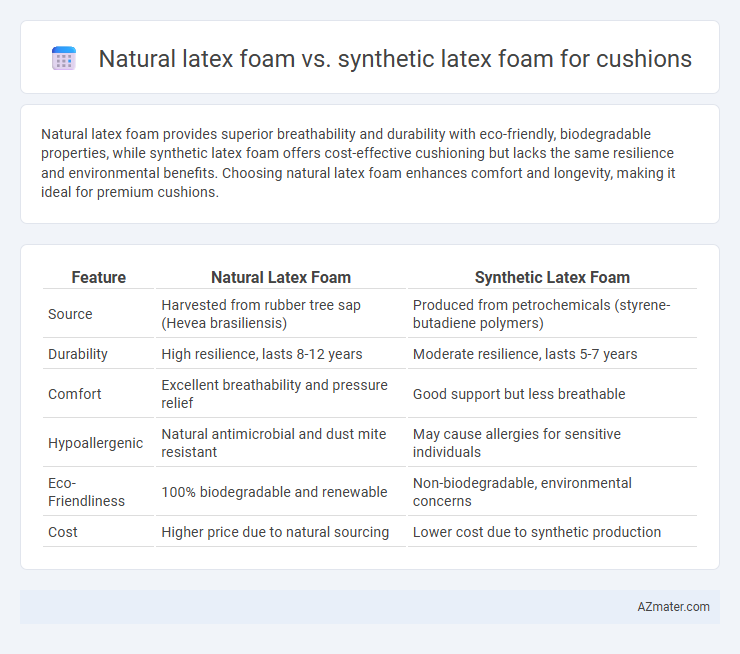Natural latex foam provides superior breathability and durability with eco-friendly, biodegradable properties, while synthetic latex foam offers cost-effective cushioning but lacks the same resilience and environmental benefits. Choosing natural latex foam enhances comfort and longevity, making it ideal for premium cushions.
Table of Comparison
| Feature | Natural Latex Foam | Synthetic Latex Foam |
|---|---|---|
| Source | Harvested from rubber tree sap (Hevea brasiliensis) | Produced from petrochemicals (styrene-butadiene polymers) |
| Durability | High resilience, lasts 8-12 years | Moderate resilience, lasts 5-7 years |
| Comfort | Excellent breathability and pressure relief | Good support but less breathable |
| Hypoallergenic | Natural antimicrobial and dust mite resistant | May cause allergies for sensitive individuals |
| Eco-Friendliness | 100% biodegradable and renewable | Non-biodegradable, environmental concerns |
| Cost | Higher price due to natural sourcing | Lower cost due to synthetic production |
Introduction to Latex Foam Cushions
Natural latex foam cushions are derived from the sap of rubber trees, offering superior breathability, hypoallergenic properties, and eco-friendly benefits. Synthetic latex foam, made from petrochemicals, provides consistent density and durability but may lack the natural resilience and biodegradability of natural latex. Understanding the differences in material composition helps optimize comfort, support, and environmental impact in cushion selection.
What Is Natural Latex Foam?
Natural latex foam is derived from the sap of rubber trees, known as Hevea brasiliensis, providing an eco-friendly and biodegradable material for cushions. It offers superior elasticity, breathability, and resilience compared to synthetic alternatives, making it ideal for pressure relief and durability. Certified natural latex foam also resists dust mites, mold, and allergens, enhancing comfort and health benefits in home furnishings.
What Is Synthetic Latex Foam?
Synthetic latex foam is a man-made material produced from petrochemicals, primarily styrene and butadiene, designed to mimic the properties of natural latex. It offers consistent density and resilience, making it a cost-effective alternative for cushions while providing good durability and support. Unlike natural latex derived from rubber tree sap, synthetic latex is more resistant to moisture and microbial growth but generally lacks the eco-friendliness and hypoallergenic benefits of natural latex foam.
Key Differences Between Natural and Synthetic Latex Foam
Natural latex foam is derived from the sap of rubber trees, making it biodegradable and hypoallergenic, while synthetic latex foam is produced from petrochemicals, often offering greater durability and resistance to wear. Natural latex typically features a more breathable structure with superior moisture-wicking properties, enhancing comfort and temperature regulation. Synthetic latex may contain fillers and chemicals that impact elasticity and resilience, whereas natural latex provides consistent support and pressure relief due to its organic cell structure.
Comfort and Support Comparison
Natural latex foam offers superior breathability and pressure relief, providing a more comfortable and cooler cushion experience due to its open-cell structure and inherent moisture-wicking properties. Synthetic latex foam, while often more affordable, usually delivers consistent support but may lack the resilience and adaptive comfort of natural latex, potentially resulting in faster degradation and reduced comfort over time. Both materials provide good support, but natural latex excels in elasticity and durability, enhancing long-term ergonomic benefits in cushions.
Durability and Longevity
Natural latex foam, derived from the sap of rubber trees, exhibits superior durability due to its inherent elasticity and resistance to wear, often lasting 10 to 15 years without significant degradation. Synthetic latex foam, made from petrochemical compounds, tends to have a shorter lifespan of around 5 to 7 years because it is more prone to breakdown under pressure and heat. The longevity of natural latex foam cushions is enhanced by their resistance to compression set, maintaining shape and support far longer than synthetic alternatives.
Allergies and Health Considerations
Natural latex foam, derived from rubber tree sap, is hypoallergenic and resistant to dust mites, mold, and bacteria, making it ideal for allergy sufferers and individuals with asthma. Synthetic latex foam, produced from petrochemicals, may emit volatile organic compounds (VOCs) and can trigger sensitivities or respiratory issues in sensitive individuals. Choosing natural latex foam reduces exposure to harmful chemicals and supports healthier indoor air quality, which is crucial for maintaining overall well-being.
Environmental Impact and Sustainability
Natural latex foam, derived from rubber tree sap, is biodegradable and renewable, significantly reducing environmental impact compared to synthetic latex, which is petroleum-based and non-biodegradable. The sustainable harvesting of natural latex supports rubber tree plantations that enhance carbon sequestration and biodiversity, whereas synthetic latex production involves high energy consumption and reliance on fossil fuels. Choosing natural latex foam for cushions promotes eco-friendly practices by minimizing carbon footprint and chemical pollution while supporting renewable resource cycles.
Cost Effectiveness and Value
Natural latex foam offers superior durability and hypoallergenic properties, making it a long-term cost-effective choice despite a higher initial price. Synthetic latex foam provides a more affordable upfront investment with decent comfort and resilience but tends to degrade faster, leading to more frequent replacements. The overall value depends on balancing budget constraints with desired longevity and environmental impact, where natural latex typically yields better return on investment over time.
Which Latex Foam Is Best for Cushions?
Natural latex foam offers superior breathability, durability, and eco-friendliness compared to synthetic latex foam, making it an excellent choice for cushions that prioritize comfort and sustainability. Synthetic latex foam, often more affordable, provides consistent support and resilience but may lack the hypoallergenic and biodegradable properties of natural latex. For cushions, natural latex foam is generally regarded as the best option due to its natural elasticity, moisture-wicking capabilities, and reduced chemical exposure.

Infographic: Natural latex foam vs Synthetic latex foam for Cushion
 azmater.com
azmater.com